Leptoptilos, known as marabou storks, are remarkable birds in various wetland and savanna habitats across sub-Saharan Africa and South Asia.
With their towering stature, distinctive bald head, and an impressive wingspan, they capture the imagination of bird enthusiasts and casual observers alike.
Their scavenging habits and adaptability to urban environments make them fascinating study subjects.
From their nesting behaviors to their ecological significance, Leptoptilos offers insights into the intricate web of life in diverse ecosystems. So, stay sharp till the end.
Physical Characteristics of Leptoptilos
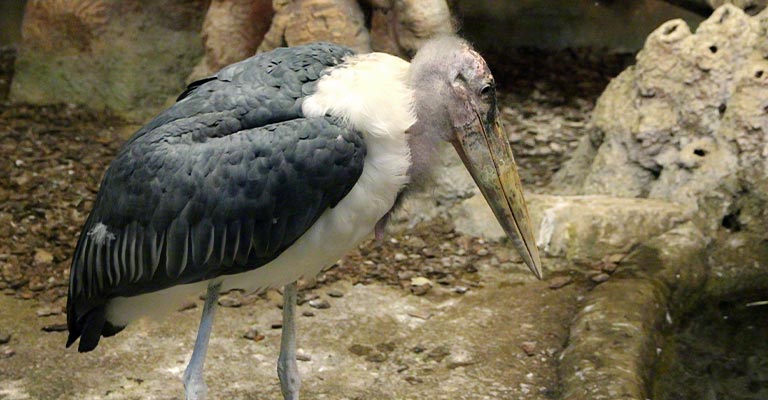
Leptoptilos is a genus of large water birds commonly known as “marabou storks.” These distinctive birds are easily recognizable due to their unique physical characteristics and behaviors.
Here are some of the key points to help identify a Leptoptilos:
Size and Shape
One of the most striking features of Leptoptilos is their large size and unique shape. They are among the tallest flying birds in the world, standing at an impressive height of up to 5 feet (1.5 meters).
Their long, slender legs and neck give them a distinctive appearance, making them easily distinguishable from other birds in their habitat.
Plumage
Leptoptilos have predominantly white plumage on their bodies, with black flight feathers on their wings and a tuft of black feathers at the tip of their tail.
The head and neck are primarily bare, with patches of black feathers scattered across the skin. This bald head and neck are among the most characteristic features of marabou storks.
Bill
Another distinguishing feature of Leptoptilos is their long, stout bill, which is thick and curved at the tip.
The bill is often yellowish, with a darker hue towards the tip. This powerful beak is well-adapted for catching and consuming a variety of prey, including fish, amphibians, and small mammals.
Legs and Feet
The legs of Leptoptilos are long and slender, with pinkish-gray coloration.
They have large, webbed feet with strong claws, ideal for wading in shallow water and grasping prey. The feet are often stained with mud or debris from their watery habitats.
Wing Span
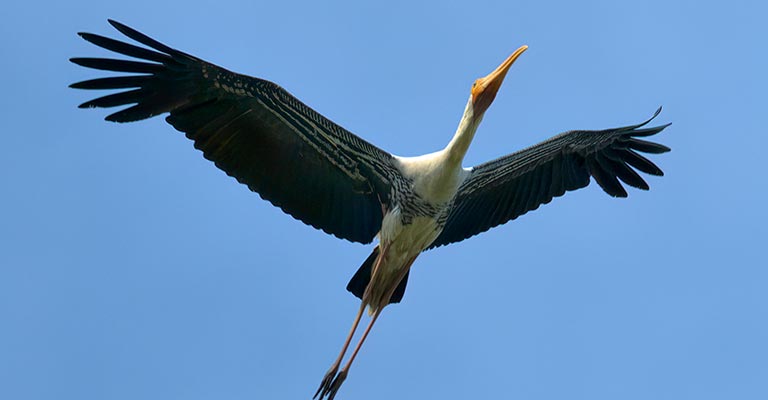
When in flight, Leptoptilos showcase an impressive wingspan, measuring up to 10 feet (3 meters) across. Their broad wings are well-suited for soaring and gliding over wetlands and marshes for food.
Behavior
Marabou storks are typically solitary birds, although they may gather in large groups at feeding sites or roosting areas. They are often found near bodies of water, such as rivers, lakes, and marshes, where they forage for food.
Voice
While not particularly vocal, Leptoptilos can produce various sounds, including grunts, hisses, and bill clattering. These vocalizations are often heard during courtship displays or when defending their territory.
Flight Pattern
When flying, marabou storks exhibit slow, deliberate wing beats, with their neck outstretched and legs trailing behind. They often soar effortlessly on thermal currents, using their keen eyesight to spot potential prey below.
Leptoptilos, or marabou storks, are easily identifiable birds due to their large size, distinctive plumage, bald head and neck, long bill, and unique behaviors.
These fascinating creatures play a vital role in their ecosystems and are a remarkable sight to behold in their natural habitats.
Taxonomy of Leptoptilos
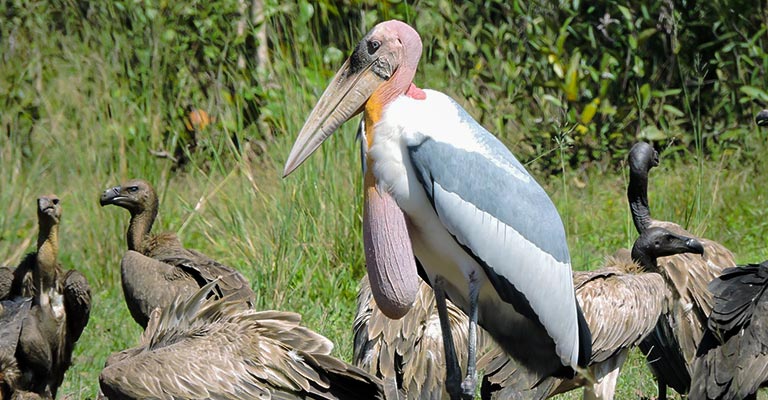
Here’s a table detailing the taxonomy of the Leptoptilos:
| Domain | Eukaryota |
| Kingdom | Animalia |
| Phylum | Chordata |
| Class | Aves |
| Clade | Aequornithes |
| Order | Ciconiiformes (Bonaparte, 1854) |
| Family | Ciconiidae |
| Genus | Leptoptilos |
| Species | L. crumenifer & 2 others |
The genus Leptoptilos encompasses three extant species, each with its unique characteristics and distribution:
Marabou Stork (Leptoptilos crumeniferus)
Found throughout sub-Saharan Africa, the marabou stork is the largest species in the genus. It is known for its massive size, bald head and neck, and distinctive black and white plumage.
Marabou storks are opportunistic feeders, scavenging on carrion and hunting live prey such as fish, amphibians, and small mammals. They often congregate in large colonies, nesting in trees near water bodies.
Greater Adjutant (Leptoptilos dubius)
Native to parts of Southeast Asia, including India, Nepal, and Cambodia, the greater adjutant is characterized by its massive size and unique neck pouch.
These birds are scavengers and often feed on carrion and hunt for fish and other small prey. Greater adjutants are considered critically endangered due to habitat loss and hunting.
Lesser Adjutant (Leptoptilos javanicus)
Similar in appearance to the greater adjutant but smaller in size, the lesser adjutant is also found in Southeast Asia, particularly in countries like India, Bangladesh, and Myanmar.
Like its larger counterpart, the lesser adjutant is a scavenger, feeding on carrion and hunting for fish and other small animals.
It faces similar habitat destruction and hunting threats, leading to its classification as vulnerable by conservation organizations.
These three species of Leptoptilos play essential roles in their respective ecosystems, contributing to nutrient cycling through scavenging and helping to control populations of small prey species.
However, they also face significant threats from human activities, highlighting the need for conservation efforts to protect their habitats and ensure their survival in the wild.
Common Food of Leptoptilos
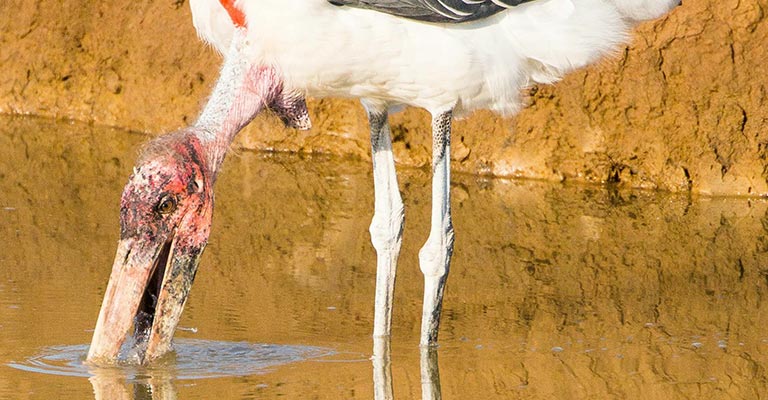
Leptoptilos, or marabou storks, are opportunistic feeders with varied diets that reflect their adaptability to different habitats. Their typical food habits include:
- Carrion: Marabou storks are scavengers and often feed on carrions, including dead fish, mammals, and birds.
- Fish: They are skilled hunters and frequently prey on fish in shallow waters, using their sharp bills and strong claws to catch their slippery prey.
- Amphibians: Leptoptilos also consume amphibians, such as frogs and toads, which they capture near water bodies.
- Insects: supplement their diet with insects, particularly during the breeding season when protein-rich food is essential for raising chicks.
- Small mammals: Marabou storks may hunt small mammals like rodents and young mammals if the opportunity arises.
- Reptiles: Occasionally, they will feed on reptiles such as snakes and lizards, especially in areas where these animals are abundant.
This varied diet allows Leptoptilos to thrive in diverse ecosystems, from wetlands and savannas to urban environments where they scavenge for scraps.
Leptoptilos Life History
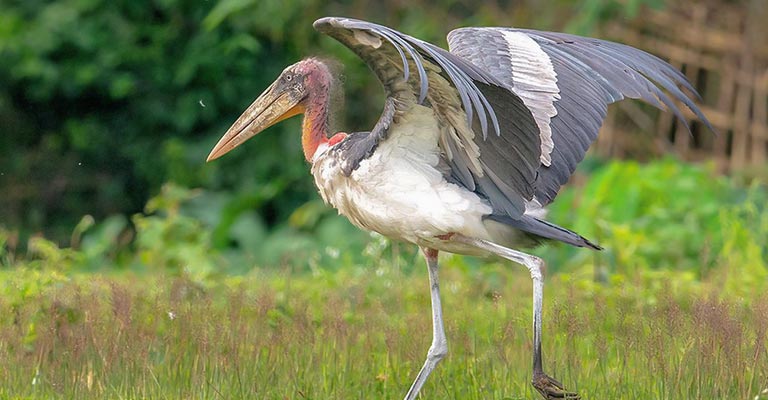
Leptoptilos, commonly known as marabou storks, are fascinating birds that inhabit various wetland and savanna ecosystems across sub-Saharan Africa and parts of South Asia.
Their distinctive appearance, with a bald head and neck, makes them easily recognizable. Let’s delve into the comprehensive life history of these remarkable birds:
Hunting Habit
Marabou storks are opportunistic feeders with versatile hunting habits. They predominantly scavenge on carrion, feeding dead fish, mammals, and birds.
However, they are also skilled hunters, preying on fish, amphibians, insects, small mammals, and reptiles.
Their sharp bill and strong claws enable them to catch prey efficiently, especially in shallow water habitats.
Habitat
Leptoptilos are adaptable birds found in various habitats, including wetlands, marshes, rivers, lakeshores, savannas, and urban areas. They prefer areas with abundant water sources, which provide ample feeding opportunities.
Despite their tolerance for human presence, they primarily inhabit undisturbed natural environments.
Range Map
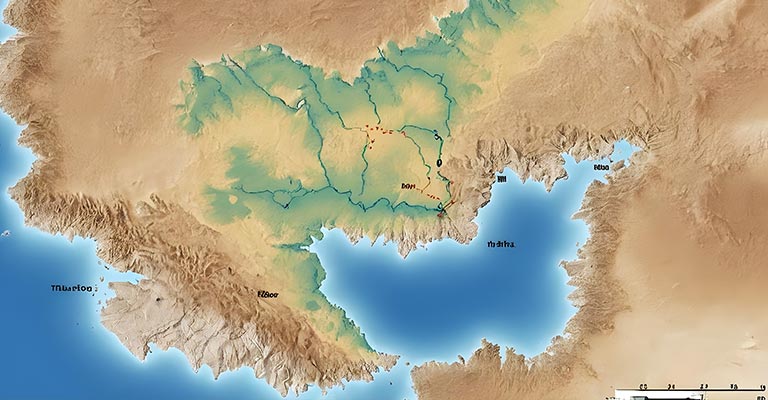
The range of Leptoptilos extends across sub-Saharan Africa, spanning from Senegal and Mauritania in the west to Ethiopia and Somalia in the east and southward to South Africa.
They also occur in isolated pockets of South Asia, including India, Nepal, and Sri Lanka. Below is a generalized range map illustrating their distribution:
Nesting
Marabou storks construct large, bulky nests made of sticks, typically in tall trees or on cliffs. They often nest in colonies, with multiple pairs breeding nearby.
Nesting sites are chosen near water bodies, providing easy access to food. Both males and females participate in nest building, incubating eggs, and caring for young.
Find out the table below detailing the nesting details of Leptoptilos, or marabou storks:
| Nesting Details | Facts |
| Clutch Size | Typically 1-3 eggs |
| Number of Broods | Both male and females participate in incubating eggs and feeding chicks |
| Egg Length | Approximately 7.5 – 9.5 cm (3 – 3.7 inches) |
| Egg Width | Approximately 5 – 6 cm (2 – 2.4 inches) |
| Incubation Period | Around 4 weeks |
| Nestling Period | About 3 months |
| Egg Description | Smooth, oval-shaped, with a chalky white shell |
| Nest Construction | Large, bulky nest made of sticks, built in trees or on cliffs |
| Nesting Sites | Typically near water bodies such as rivers, lakes, or marshes |
| Parental Care | Chicks are altricial and are initially helpless, requiring parental care and feeding. |
| Developmental Stages | Chicks are altricial and are initially helpless, requiring parental care and feeding |
This table provides a comprehensive overview of the nesting behavior and reproductive biology of Leptoptilos, highlighting key facts such as clutch size, nest construction, and parental care.
Breeding
Breeding season varies depending on the region, typically coinciding with the onset of the rainy season. Marabou storks form monogamous pairs during the breeding season, engaging in elaborate courtship displays.
Females lay one to three eggs, which are incubated for about a month. Chicks are altricial and are cared for by both parents until they fledge.
Diseases and Treatment
Marabou storks may be susceptible to various diseases, including avian influenza, avian cholera, and Newcastle disease.
Conservation efforts often involve monitoring and managing disease outbreaks through vaccination programs and providing medical treatment to affected individuals.
Conservation
Leptoptilos face threats such as habitat loss, pollution, and poaching. Wetland degradation and human encroachment on their habitats pose significant challenges to their survival.
Conservation efforts focus on habitat preservation, raising awareness, and implementing measures to mitigate human-wildlife conflicts.
Leptoptilos, or marabou storks, exhibit fascinating life history traits, from their diverse hunting habits and nesting behaviors to their conservation challenges and efforts.
Understanding their biology and ecological requirements is crucial for ensuring the long-term survival of these iconic birds.
10 Fun Facts About Leptoptilos

Leptoptilos, commonly known as marabou storks, are fascinating birds with a distinctive appearance and intriguing behaviors. Here are 10 fun facts about these remarkable avians:
- Impressive Size: Marabou storks are among the tallest flying birds in the world, standing up to 5 feet (1.5 meters) tall, with a wingspan of up to 10 feet (3 meters).
- Bald Head and Neck: One of their most notable features is their bald head and neck, often covered in patches of black feathers. This unique appearance sets them apart from other bird species.
- Scavenging Specialists: Marabou storks are expert scavengers, feeding on carrions such as dead fish, mammals, and birds. They play a crucial role in cleaning ecosystems by consuming decaying organic matter.
- Varied Diet: While scavenging is their primary feeding behavior, marabou storks also hunt live prey, including fish, amphibians, insects, and small mammals, showcasing their adaptability.
- Nesting Colonies: These birds often nest in large colonies, with multiple pairs breeding nearby. Their nests, made of sticks, can be found in tall trees or on cliffs near water bodies.
- Social Behavior: Despite being primarily solitary feeders, marabou storks are social birds, often congregating in large groups at feeding sites or roosting areas.
- Longevity: Marabou storks can live up to 25 years in the wild, while those in captivity may reach even greater ages under optimal conditions.
- Distinctive Vocalizations: While not particularly vocal, marabou storks produce various sounds, including grunts, hisses, and bill clattering, which they use for communication and during courtship displays.
- Urban Dwellers: These adaptable birds are often found in urban environments, scavenging for food scraps in garbage dumps, markets, and other human settlements.
- Conservation Status: Although not currently considered globally threatened, marabou storks face threats such as habitat loss, pollution, and poaching. Conservation efforts are essential to ensure their continued survival in the wild.
These fun facts offer a glimpse into the intriguing world of Leptoptilos, highlighting their unique characteristics and ecological importance.
Wrapping Up
Leptoptilos, or marabou storks, exemplify the marvels of avian adaptation and ecological significance. From their towering stature to their distinctive bald head and neck, these birds captivate observers with their unique appearance.
Their role as scavengers not only aids in ecosystem cleanup but also demonstrates their adaptability and resourcefulness in finding food sources.
Furthermore, the social dynamics of nesting colonies and their occasional urban presence illustrate their ability to thrive in diverse environments, showcasing their resilience in the face of habitat changes brought about by human activities.
While marabou storks are not currently facing imminent threats to survival, continued conservation efforts are crucial to mitigate potential risks such as habitat loss, pollution, and poaching.
By preserving their natural habitats and raising awareness about their importance in ecosystems, we can ensure the long-term viability of these magnificent birds. Best wishes to you.